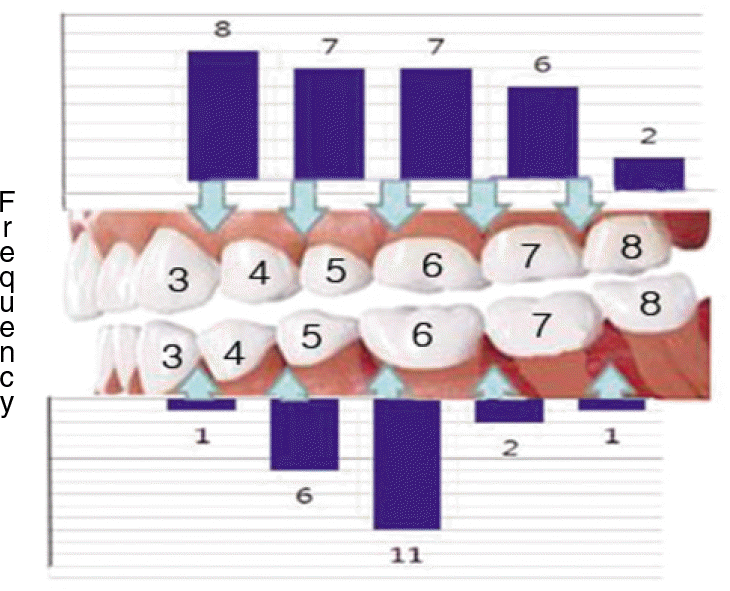Abstract
Purpose
The purpose of this study was to investigate the food impaction between implant prostheses and adjacent natural teeth.
Materials and methods
For this study, 51 patients with food impaction were selected and investigated mobility, tightness of contact area, gingival index, plaque index, attachment loss, alveolar bone level, proximal caries, marginal ridge distance and occlusal relationships.
Results
Food impaction was found in the upper teeth (60.7%) more than the lower teeth (39.2%). Food impaction was occurred on mesial side of implant prostheses (86.2%) more than distal side (13.7%). Food impaction was mostly found in loose or open contact area (94.2%). Food impaction was frequent on stepped relationship between implant and adjacent teeth.
Conclusion
Treatment plan should include proper adjacent and antagonistic occlusal plane and occlusal surface, to prevent food impaction, and the plan should include less adjacent tooth mobility with proper tightness between implant prostheses and adjacent teeth. (J Korean Acad Prosthodont 2014;52:27-33)
Go to : 
REFERENCES
1.Hirschfeld I. Food impaction. J Am Dent Assoc. 1930. 17:1504–28.
2.Takahashi T. Diagnosis of food impaction. Nihon Shika Ishikai Zasshi. 1980. 33:3–10.
3.Spielman AI., Bivona P., Rifkin BR. Halitosis. A common oral problem. N Y State Dent J. 1996. 62:36–42.
4.Diamond M. Dental Anatomy. New York, MacMillan Co.;1929.
5.Kraus BS., Jordan RE., Abrams LA. Dental Anatomy and Occlusion. Baltimore, The Williams and Wilkins Company;1969.
6.Kepic TJ., O'Leary TJ. Role of marginal ridge relationships as an etiologic factor in periodontal disease. J Periodontol. 1978. 49:570–5.

7.Prichard JE. Advanced Periodontal Disease/Surgical and Prosthetic Management. 2nd ed. Philadelphia, WB Saunders;1972.
8.Takei HH. The interdental space. Dent Clin North Am. 1980. 24:169–76.
9.Hancock EB., Mayo CV., Schwab RR., Wirthlin MR. Influence of interdental contacts on periodontal status. J Periodontol. 1980. 51:445–9.

10.Jernberg GR., Bakdash MB., Keenan KM. Relationship between proximal tooth open contacts and periodontal disease. J Periodontol. 1983. 54:529–33.

11.Tarnow DP., Magner AW., Fletcher P. The effect of the distance from the contact point to the crest of bone on the presence or absence of the interproximal dental papilla. J Periodontol. 1992. 63:995–6.

12.Jung JH., Oh SC., Dong JK. A clinical study on the occurrence of food impaction. J Korean Acad Prosthodont. 2000. 38:50–8.
13.O'Leary TJ., Badell MC., Bloomer RS. Interproximal contact and marginal ridge relationships in periodontally healthy young males classified as to orthodontic status. J Periodontol. 1975. 46:6–9.
14.Korean Academy of Periodontology. Periodontology. Seoul, Goonja Publishing;2010.
15.O'Leary TJ., Gibson WA Jr., Shannon IL., Schuessler CF., Nabers CL. A screening examination for detection of gingival and periodontal breakdown and local irritants. Periodontics. 1963. 1:166–74.
16.Silness J., Löe H. Periodontal disease in pregnancy. II. Correlation between oral hygiene and periodontal condtion. Acta Odontol Scand. 1964. 22:121–35.
17.Tibbetts LS Jr. Use of diagnostic probes for detection of periodontal disease. J Am Dent Assoc. 1969. 78:549–55.

18.Haffajee AD., Cugini MA., Dibart S., Smith C., Kent RL Jr., Socransky SS. Clinical and microbiological features of subjects with adult periodontitis who responded poorly to scaling and root planing. J Clin Periodontol. 1997. 24:767–76.

19.Rudd KD., O'Leary TJ., Stumpf AJ Jr. Horizontal tooth mobility in carefully screened subjects. Tech Doc Rep U S Air Force Syst Command Electron Syst Div. 1964 Feb. 94:1–6.
Go to : 
Table 1.
Criteria of oral examination
Table 2.
Result of questionnaire on the food impaction after restoration
Table 3.
Tightness of the contact point in the site with food impaction
| N | Percentage | ||
|---|---|---|---|
| Tightness | tight | 3 | 5.80% |
| loose | 34 | 66.60% | |
| open | 14 | 27.40% |
Table 4.
Result of periodontal examination




 PDF
PDF ePub
ePub Citation
Citation Print
Print



 XML Download
XML Download